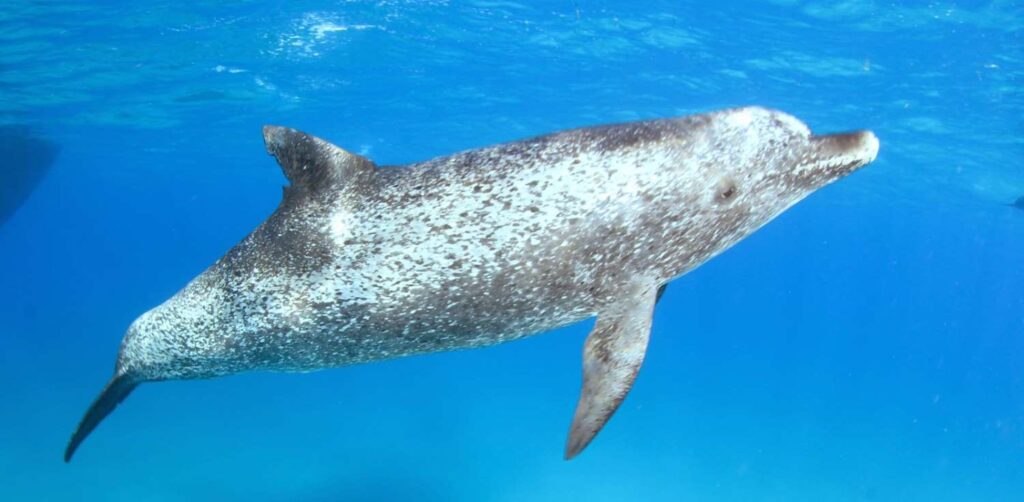Spotted Dolphins
The friendliest Bahamas Dolphins
Our guided wild Spotted Dolphin encounters offer a unique opportunity to witness these charismatic beings in their natural habitat, fostering a connection between humans and these remarkable creatures. Immerse yourself in the magic of the Bahamas and create memories that will last a lifetime with the friendliest dolphins in the region—Spotted Dolphins await to make your aquatic adventure truly extraordinary.
Atlantic Spotted Dolphin (Stenella frontalis)
A Closer Look at Their Near-Shore Habitat, Unique Spotted Patterns, and Complex Social Lives
The Atlantic Spotted Dolphin (Stenella frontalis) is considered a near-shore, non-migrating species ranging the temperate and tropical coastal waters of the Atlantic. Although they are widespread, their abundance still needs to be estimated by official studies, though the general presumption is that their numbers are potentially significant. Spotted Dolphins range throughout the Bahamas, with specific areas having resident pods, such as Bimini. There are numerous different pods throughout the Bahamas, with some individuals moving between different pods.
As the name suggests, they are commonly recognized by their spots that develop as they age. They are born without spots; they are dark gray on their backs, graduating along their sides to a white belly. At approximately four years of age, they begin to get spots. As the dolphins age, black spots fill in the light underside, white spots fill the darker upper sides and back. The spotting patterns take on a mottled appearance in adults, eventually fusing together on older dolphins. This helps us with age estimates as well. The older adults become so fused with spots their bellies appear almost black with white specks.
Spotted Dolphins
are usually 5-7 ft (1.6-2.1 m) long and weigh about 200-300 lbs (93-135 kg). Interestingly, their average lifespan has not been estimated, although it is general knowledge that they live more than 40 years. They have a robust body with a tall, “falcate” dorsal fin midway down their back. The rounded “melon” is separated from the moderately long beak by a distinct crease. Coloration and patterns vary with age, life stage, geographic location, and genetics.
Atlantic spotted dolphins
are usually found in groups of fewer than 35 individuals but have been occasionally seen in larger groups of around 100 animals. Since they are mammals, they must visit the surface often to replenish oxygen. They generally make dives of about 30 ft (10 m) or less for 2-6 minutes but can reach depths of 130-200 ft (40-60 m) and have been recorded holding their breath for up to 15 minutes.
Dolphins lead very complex social lives. They exhibit numerous social behaviors like companionship, affection, aggression, and playfulness. Regardless of the relationship, when two dolphins are swimming together, they will be in almost constant physical contact with each other.
Female Spotted Dolphin
reach maturity around 12 years old. Gestation period for a pregnant female is 11 to 12 months. The baby is born within a group of other dolphins. For the first couple of months the newborn stays close to its mother or a baby sitter. The young are always more playful and curios like many other mammal species. Nursing goes on for over two years at which time the baby stays in the general area of the mother but is becoming more independent. The young stay around it’s mother for up to four years but the mother can have a new baby by the third year. Females grow up around their mothers and other females until over 11 years when they become fertile. This is when the females start courtship games with the males and become pregnant. Then they settle to a more serious life of feeding, offspring, and nursing.
They have a unique swimming style. It is often described as acrobatic due to their frequent “breaching,” jumping, and other aerial activities at the surface. They are capable of swimming at very fast speeds and often approach vessels to “bow ride”.
Spotted Dolphins are nocturnal dolphins that feed at night. see more about night time dolphin encounters.
SPOTTED DOLPHIN PATTERNS and AGE GUIDE:







Bahamas Spotted Dolphin Identification Project
The Dolphin Dream Team promotes research and education through observation, interaction and play
Identification of individual Atlantic Spotted Dolphin is central to any research on this free-ranging species. It is essential to helping us understand behaviors over a number of years by knowing who’s who.
The identification and cataloging of each individual is done by photographs of both sides of the dolphin.



